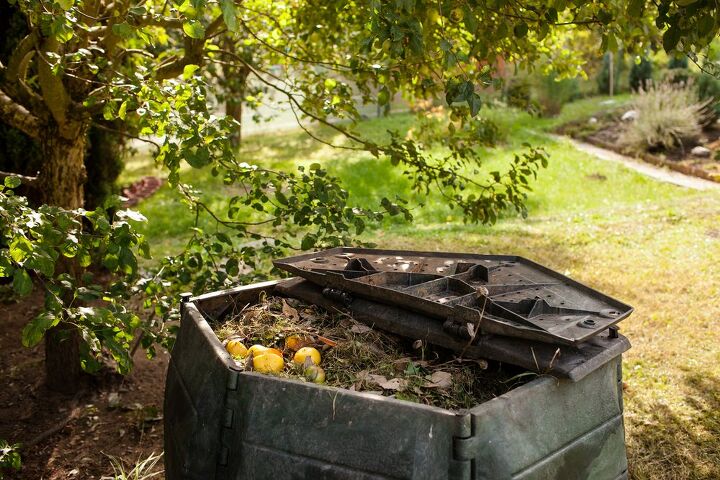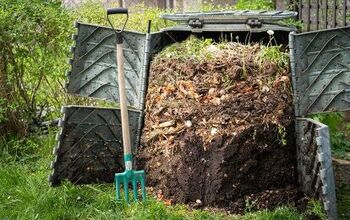Why Is My Compost Is Too Wet, And How Do I Fix It?

Whether you’re experienced or new to composting, you likely know that it involves many nuances. Moisture control is one of the trickiest composting elements to control, especially when your compost becomes too wet. There are many reasons why your compost is too wet, and they are all fixable.
Your compost may be too wet because you overwater it and add too many fresh fruits and vegetables. Add absorbent materials like sawdust, newspapers, and even peat moss to your compost to maintain a water content between 40% and 60%. Otherwise, your compost won’t reach a 120-140-degree internal temperature, and weeds and flies may thrive.
You can also help reduce the moisture if you stir the compost to maximize aeration. Follow along as we explore why your compost is too wet and see how you can fix it.
Is Compost Supposed To Be Wet?
Your compost pile should be wet, but it shouldn’t exceed 60% water. Ideally, you should maintain between 40% to 60% water content for your compost pile. The microbial organisms within your compost pile need at least some water to thrive.
Microbes can’t survive if your compost pile becomes too dry, so it’s important to find a perfect balance, because it cannot reach the 120-140-degree composting temperature that you need. Flies, pathogens, and weeds will thrive within your compost pile if it can’t reach a high internal temperature.
Conversely, excessive water slows down the decomposition rate and you won’t see results anytime soon. Some people weigh their compost and compare the wet and dry weights to check the moisture. However, it’s easier to grab a few handfuls from the pile to make sure it feels damp, but not soaked.
Why Is My Compost So Wet?
If your compost is too wet, it’s likely because you’ve included too many fresh materials. Fresh fruits and vegetables can create a wet, “slimy” consistency that affects your compost pile. The moisture will sit longer if your compost pile is in a spot that doesn’t get much sunlight or heat.
Eventually, your wet compost pile may smell like sewage if it doesn’t get a chance to dry a bit. Many people frequently add water and fresh fruits to their compost piles. However, you shouldn’t water your compost pile more than once per week.
That’s especially true if you also add fresh fruits and vegetables to the pile that week. This will make your compost pile too wet, and it may become moldy. Be careful about how often you add grass clippings to your compost pile, as that’s a common cause of excessive moisture.
What To Do If Your Compost Is Too Wet
There’s no reason to panic if your compost is too wet. It’s easy to fix the situation and reduce the moisture, so the microbes can thrive. Let’s look at a few simple tricks you can use to fix a compost pile that’s too wet.
Use Absorbent Materials
Put absorbent materials, such as sawdust, in your compost pile if it’s too dry. This method can take a while, but that’s part of what makes it so effective. You won’t disrupt the microbes, and you will add materials to the pile that will help the decomposition process.
Leaves, newspapers, peat moss, and hay are also great absorbent materials that can help dry your compost pile. Carefully mix the absorbent materials into the pile and stir it. The materials will slowly pull moisture from the oversaturated compost.
This method is quite effective, because there isn’t much risk that you will dry the pile out too much. Check on your compost pile after a day to see if the sawdust and leaves feel damp. Simply add more leaves and sawdust if the surrounding material still feels oversaturated.
Stir The Pile
The fastest way to fix compost that is too wet is to stir the pile. This helps provide more sunlight and warm air to parts of the compost that are oversaturated and buried deep. Be careful, so you can still maintain layers of green and brown for the best results.
Is your compost pile oversaturated throughout each layer? If so, you may want to scoop the contents out and put them on a tarp. Lay the tarp out in the sun so that the compost can dry quickly.
That said, you must keep a close eye on the compost to make sure it doesn’t get too dry. Put the compost back in the pile once it feels damp, but not too wet. Make sure that the compost pile isn’t packed too tightly, to ensure there is enough aeration. Otherwise, the compost will become too wet again.
Use A Nitrogen Activator
Nitrogen is an essential part of any compost pile, as it helps fuel the microbes. This can help ensure a perfect internal temperature, and that’s necessary if you want a normal decomposition timeline. Your compost pile can become too wet if it doesn’t have enough nitrogen-rich materials.
Bonemeal, alfalfa, clover, and manure are great nitrogen activators that can maintain an ideal temperature. However, it’s important to maintain a 50% green to 50% brown ratio, so you don’t slow down the decomposition process. Excessive nitrogen can make your compost pile smell bad, and it can be unbearable.
It can take 24 to 48 hours for the nitrogen activators to affect your compost pile. Factors like the outside temperature and humidity, as well as your compost pile’s aeration, affect the timeline. Stir your compost and add more nitrogen activators if you don’t see results after 2 days.
Cover The Compost
Cover your compost to maintain a healthy moisture level. You don’t need to cover the pile all the time, but you should at least cover it overnight or for a good portion of the day. The local climate where you live will ultimately determine how often you should cover your compost.
For example, people who live in Louisiana and Missouri may need to cover their compost more than people in California. The high humidity level in Louisiana compared to the dry air in Southern California couldn’t be more different. Cover your compost on humid and rainy days if your pile is too wet and uncover it if it dries out.
Summing It Up
Your compost can become too wet if you add too many fresh materials, such as fruits and vegetables. Cover your compost and add absorbent materials like newspaper and sawdust to help dry it out. Make sure the water content of your compost stays between 40% and 60% so it’s not too wet or dry.
Related Guides:

Nick Durante is a professional writer with a primary focus on home improvement. When he is not writing about home improvement or taking on projects around the house, he likes to read and create art. He is always looking towards the newest trends in home improvement.
More by Nick Durante



























